My family's brasserie's cuisine is just good old fashioned home-cooked food, but there are exceptions to our homemades. Like this sublime Porchetta recipe that we sourced from The Circle of Misse. This is gastronomic quality, the flavour, rustic and as homely as it gets.
Recipe Index - circleofmisse.com
Yummy Porchetta

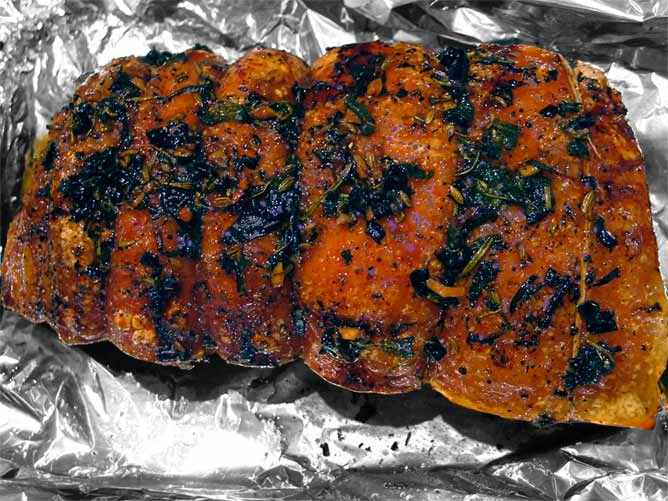
Porchetta is a rich dish and a little goes a long way. Porchetta is a classic Italian pork roast. It has been recognised with a 'prodotto agroalimentare tradizionale' (traditional agricultural-alimentary product).
The original is made with a whole small pig, which has been gutted, de-boned, stuffed with herbs, garlic and wild fennel then spit roasted. It is commonly seen in this form in Butcher's shops and is bought by the slice. It can be eaten warm or cold.

Tips:
We have found that the best cut to use in the home is belly of pork. It must be a good traditional belly with good layers of fat. The modern trend towards leaner pigs is a killer to a dish like this as the long slow cooking requires plenty of fat which renders slowly.
This dish needs to be made with fresh herbs. Dried herbs won't work well.
When using butcher's twine, looping twice makes it easier to put the final knot in.
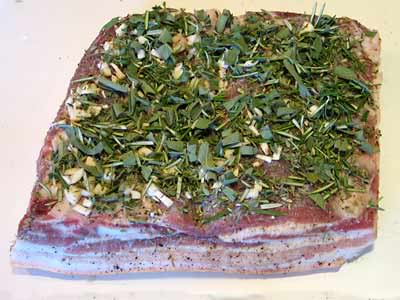
1 pork belly weighing 1.5kg \ 3lbs
bunch of fresh thyme, sage & rosemary, leaves removed and roughly chopped
4 cloves of garlic
2 teaspoons of fennel seeds
juice and grated zest of half a lemon
2 tablespoons of Olive Oil
a pinch or two of sea salt, coarsely crushed
coarsely ground black pepper
honey, to glaze
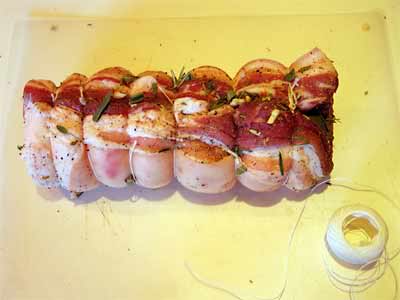
Tools of the trade
Butcher's twine\string
Deep roasting dish
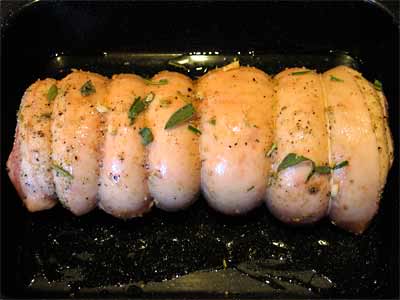
Method
Preheat the oven to its highest setting.
Wash and thoroughly dry the pork belly. Lay the belly skin side down and rub half of the salt and a few generous pinches of pepper into the belly. Cover and leave for 10-15 minutes.
Take the fennel seeds and heat them in a frying pan until you can just smell their fragrance. Place the fennel seeds, garlic, lemon zest and herbs on top of the belly.
Now take some butcher's twine\string and tie up the belly in several places. To achieve this I tie two 'practice knots' to hold the meat as I want it. I then tie each end, the middle and as many knots as I need between the two. Some of the stuffing will fall out. Simply stuff it back when you are finished.
Baste the exterior with 1-2 tablespoons of olive oil and then rub in the rest of the salt and a couple of pinches of pepper. Grease a roasting dish with a little olive oil and place the rolled joint into it.
Put into the hot oven for 8-10 minutes then turn over and cook on the other side for a further 6-8 minutes. Be vigilant and keep an eye on it at this time. We don't want any part to burn.
Lower the oven temperature to 150°C \ 300°F \ Gas mark 2 and cook for two hours, turning occasionally.
Remove from the oven, pour over 3-4 tablespoons of honey mixed with the lemon juice and leave to sit for at least 20 minutes.
The crackling from this dish is amazing but makes carving very difficult. Remove the crackling to facilitate carving the joint, then carve or cut up the crackling separately.
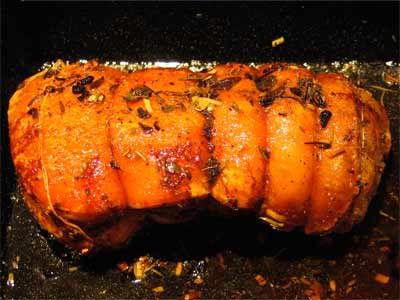
Suggestion
If you can get hold of wild fennel, use in place of fennel seeds. Its flavour is extraordinary.

Porchetta is a rich dish and a little goes a long way. Porchetta is a classic Italian pork roast. It has been recognised with a 'prodotto agroalimentare tradizionale' (traditional agricultural-alimentary product).
The original is made with a whole small pig, which has been gutted, de-boned, stuffed with herbs, garlic and wild fennel then spit roasted. It is commonly seen in this form in Butcher's shops and is bought by the slice. It can be eaten warm or cold.

Tips:
We have found that the best cut to use in the home is belly of pork. It must be a good traditional belly with good layers of fat. The modern trend towards leaner pigs is a killer to a dish like this as the long slow cooking requires plenty of fat which renders slowly.
This dish needs to be made with fresh herbs. Dried herbs won't work well.
When using butcher's twine, looping twice makes it easier to put the final knot in.

1 pork belly weighing 1.5kg \ 3lbs
bunch of fresh thyme, sage & rosemary, leaves removed and roughly chopped
4 cloves of garlic
2 teaspoons of fennel seeds
juice and grated zest of half a lemon
2 tablespoons of Olive Oil
a pinch or two of sea salt, coarsely crushed
coarsely ground black pepper
honey, to glaze

Tools of the trade
Butcher's twine\string
Deep roasting dish

Method
Preheat the oven to its highest setting.
Wash and thoroughly dry the pork belly. Lay the belly skin side down and rub half of the salt and a few generous pinches of pepper into the belly. Cover and leave for 10-15 minutes.
Take the fennel seeds and heat them in a frying pan until you can just smell their fragrance. Place the fennel seeds, garlic, lemon zest and herbs on top of the belly.
Now take some butcher's twine\string and tie up the belly in several places. To achieve this I tie two 'practice knots' to hold the meat as I want it. I then tie each end, the middle and as many knots as I need between the two. Some of the stuffing will fall out. Simply stuff it back when you are finished.
Baste the exterior with 1-2 tablespoons of olive oil and then rub in the rest of the salt and a couple of pinches of pepper. Grease a roasting dish with a little olive oil and place the rolled joint into it.
Put into the hot oven for 8-10 minutes then turn over and cook on the other side for a further 6-8 minutes. Be vigilant and keep an eye on it at this time. We don't want any part to burn.
Lower the oven temperature to 150°C \ 300°F \ Gas mark 2 and cook for two hours, turning occasionally.
Remove from the oven, pour over 3-4 tablespoons of honey mixed with the lemon juice and leave to sit for at least 20 minutes.
The crackling from this dish is amazing but makes carving very difficult. Remove the crackling to facilitate carving the joint, then carve or cut up the crackling separately.

Suggestion
If you can get hold of wild fennel, use in place of fennel seeds. Its flavour is extraordinary.
